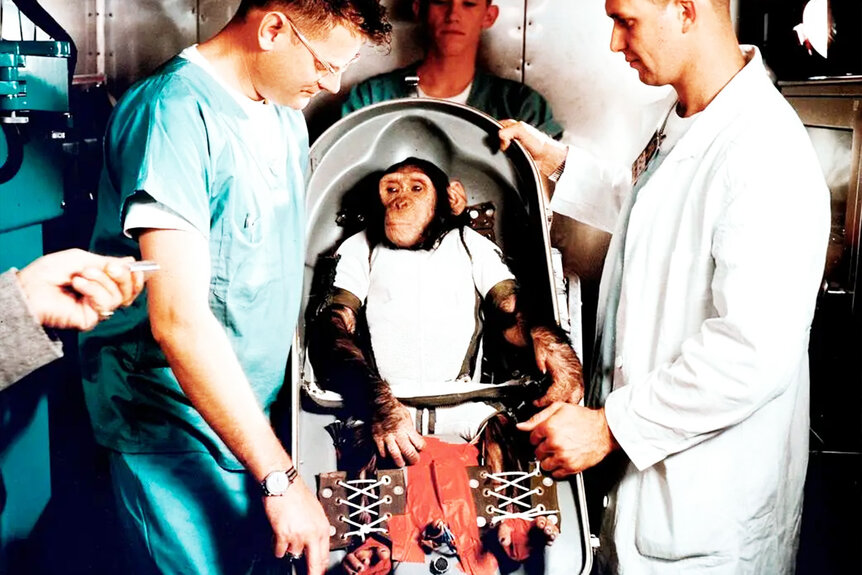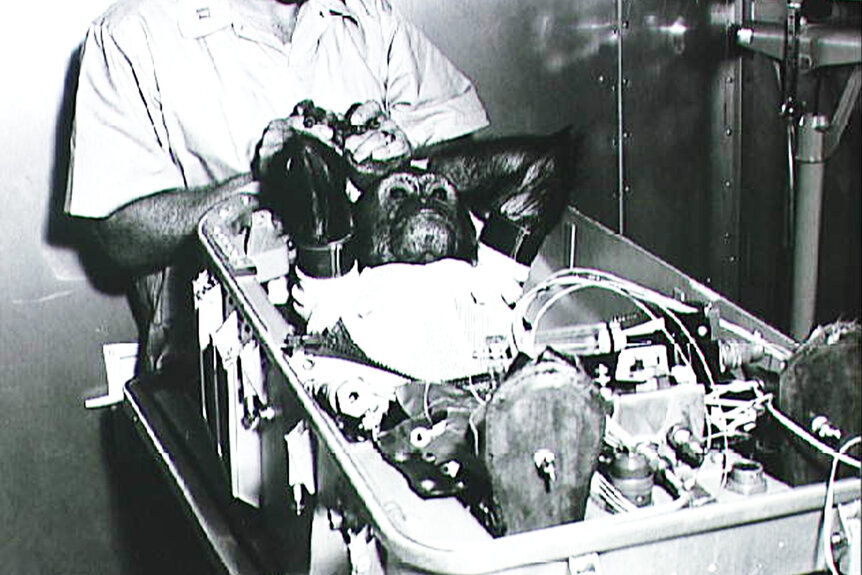Create a free profile to get unlimited access to exclusive videos, sweepstakes, and more!
Chimps in Space: Remembering Enos, the Chimpanzee Who Orbited the Earth
Chimpanzees paved the way for human space exploration.
The 2011 found footage film Apollo 18 (streaming now on Peacock!) tells the story of a secret crewed Moon mission and the cover up that followed. The Apollo 18 mission (canceled in real life) was picked up again and tasked with secretly delivering a Department of Defense payload to the Moon’s South Pole. All three crew members were lost during the mission and their deaths were explained away as training accidents.
Fictional secret space missions aside, there are plenty of unsung heroes in the history of space exploration. We remember the John Glenns, the Neil Armstrongs, the Sally Rides, and forget most of the rest. The average human astronaut could walk down the street without being recognized and that’s without even considering the animals who paved the way for human spaceflight.
NASA’s Project Mercury began in earnest on August 21, 1959, and a couple years later astronauts were orbiting the world. A decade after that we were walking on the Moon like it was no big deal. There were a total of 20 test missions leading up to John Glenn’s historic orbital flight on February 20, 1962. Those 20 missions were largely uncrewed, but two of them carried chimpanzees, whose contributions were critical to the success of the United States space program.
For More on Space:
NEAR and Eros: The Story of the First Asteroid Landed on by a Spacecraft
Why Sierra Space Popped Its Inflatable Space Station Module on Purpose
The Life and Death (in 2031) of the International Space Station
Ham, the First Chimpanzee in Space
It’s hard to believe today, but when space exploration was young it wasn’t totally clear if living things could survive a trip off planet. To find out, scientists sent a variety of organisms including plants, mice, rabbits, rhesus monkeys, Philippine monkeys, squirrel monkeys, dogs, and apes.
Yuri Gagarin may have become the first human being in space when he launched aboard Vostok 1 on April 12, 1961, but he was not the first hominid. That honor goes to a chimpanzee named Ham, who blasted into space a few months earlier on January 31, 1961. Ham launched from Cape Canaveral aboard a Mercury-Redstone rocket and reached an altitude of 158 miles while performing a lever pulling task. Alan Shephard would make a very similar flight, becoming the first U.S. astronaut in space, just a few months later, on May 5, 1961.
Ham experienced 6.6 minutes of weightlessness during a 16.5-minute flight. When he splashed down in the Atlantic, he was a little dehydrated and tired, but otherwise in good health. In 1963, Ham went to live at the Washington Zoo where he stayed until 1980. He then moved to the North Carolina Zoological Park where he remained until his death in 1983. His skeleton has been kept for ongoing study and the rest of his remains were interred at the International Space Hall of Fame in New Mexico.
Enos, the First Chimpanzee to Orbit the Earth
With the first chimpanzee (and human) spaceflights in the bag, NASA turned its attention to putting a person into orbit. Before the Mercury spacecraft and the Atlas booster could be certified for human flight, they needed to prove it could carry a living thing into orbit and return it safely to the ground. That’s where Enos came in.
Enos was a 5-year-old chimpanzee who launched into orbit on November 29, 1961. Mission controllers had originally planned a total of three orbits but trimmed the mission to just two because of a fuel problem during flight. During the mission, Enos was monitored from the ground to ensure he remained physically healthy. A problem with the environmental controls during the second orbit caused Enos’ temperature to spike before leveling out once the controls kicked back in.
After two orbits, the spacecraft splashed down about 200 miles south of Bermuda and was soon recovered. Enos survived the mission in good health, though he apparently spent some of his flight time removing the electrodes and other devices from his body.
Enos died about a year after completing his mission, from a case of dysentery unrelated to his time in space. Despite the tragic and untimely death of Enos, it was only because of his flight that the Mercury spacecraft and booster were certified and U.S. involvement in the space race really kicked off. Without Enos, without Ham and all the rest, we never would have made it to the Moon.
And we never could have imagined the secret and horrific Apollo 18, streaming now on Peacock.




















